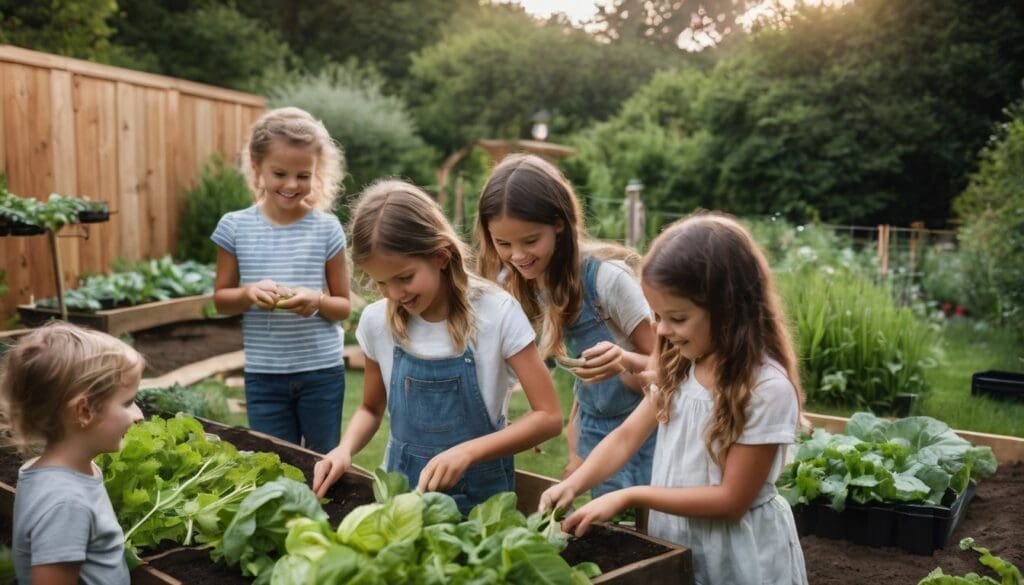Navigating the world of green living with our little ones can sometimes feel like a bit of a jigsaw. Oh, we understand the challenges all too well – making those eco-friendly choices and discovering that children hold the key to unlocking up to 20% in household energy savings simply through small yet impactful behavioural tweaks.
Our thoughtfully gathered insights will steer you through delightful activities and fundamental teachings, fostering an instinctive sense for sustainability in your youngsters. So come along, let’s embark on this journey together for a brighter, greener tomorrow!
Key Takeaways
- Teach children the importance of sustainability by engaging them in outdoor activities such as camping, nature art, and gardening, which help them appreciate the environment and learn practical skills.
- Organising local clean – up drives with kids not only benefits our neighbourhoods but also instils a sense of environmental responsibility and community service in young minds.
- At home, practice the Three Rs (Reduce, Reuse, Recycle) with simple daily actions like using reusable containers and setting up recycling bins to cultivate eco-friendly habits from an early age.
- Educate children on water conservation through practices like rainwater harvesting; this teaches them about resource management and the impacts of water usage on the planet.
- Inspire kids to support their local economy and reduce carbon footprints by shopping at local businesses; doing so promotes stronger communities committed to sustainable living.
Importance of Teaching Kids About Green Living
Teaching children about sustainability lays the foundation for a healthier planet. When we instil in kids the significance of green living, we are equipping them with vital tools to make informed decisions as they grow.
They’ll learn to value resources and understand the impact their choices have on the earth.
Integrating eco-friendly activities into our families’ daily routines demonstrates a commitment to environmental education. We foster nature appreciation and create habits that can significantly reduce our ecological footprint.
As kids embrace an eco-conscious lifestyle, they become role models, inspiring others around them to follow suit.
Through hands-on sustainable activities, kids grasp complex environmental issues in simpler terms. Gardening together or participating in local clean-up drives helps them experience first-hand the benefits of preserving natural habitats.
This active engagement is crucial for building young individuals who are aware and ready to champion Earth-friendly practices.
Nurturing an ecofriendly mind-set from childhood promotes long-term positive behaviour towards our environment. Our collective effort now shapes future generations who will be responsible stewards of this planet – making green living not just a choice but a way of life for all coming years.
Eco-Friendly Activities for Kids
Engage your kids in outdoor activities such as camping, nature art, and gardening to instil a love for nature. Let them learn about animals and their habitats through interactive experiences, and organise clean-up drives to teach the importance of environmental conservation.
Outdoor Activities: camping, nature art, gardening
Teaching children about sustainability includes engaging them in outdoor activities that foster a love for nature and the environment. Here are some eco-friendly activities to inspire kids and promote environmental awareness:
- Camping: Connecting with nature through camping adventures helps children appreciate the outdoors and learn important survival skills.
- Nature Art: Creating art using natural materials such as leaves, flowers, and stones encourages creativity while instilling a sense of respect for the environment.
- Gardening: Growing their own fruits, vegetables, or flowers teaches kids about the importance of sustainable living and caring for the earth’s resources.
Learning about animals and their habitats
Exploring the natural world through active engagement in outdoor activities like camping, nature art, and gardening provides an opportunity for children to learn about animals and their habitats.
Observing wildlife in its natural environment can foster a deep appreciation for the diversity of species and ecosystems. By taking part in hands-on experiences such as birdwatching or exploring local ponds, children can develop a better understanding of how different creatures interact with their habitats.
Encouraging kids to appreciate nature by studying animals and habitats not only sparks curiosity but also nurtures a sense of responsibility towards conservation efforts. Engaging young minds in learning about animal behavior, food chains, and adaptations helps them connect with the environment on a personal level while instilling values of empathy and environmental stewardship.
Clean-up drives
Clean-up drives are a fantastic way to teach children about caring for the environment. These activities not only help to keep our surroundings clean but also instil a sense of responsibility and respect for nature in kids. Here are some ways to organise and conduct clean-up drives with your children:
- Organise a local park or beach clean – up event, involving other families and friends.
- Provide children with reusable gloves, bags, and tools for collecting litter safely.
- Explain the importance of proper waste disposal and recycling while cleaning up.
- Teach kids about the impact of litter on wildlife and marine life.
Lessons about Sustainability at Home
Let’s look at some practical ways to teach kids about sustainability within the home, from practicing the Three Rs to supporting local businesses and rainwater harvesting. Read more for creative ideas on how to make green living a fun family effort!
Practice the Three Rs
- Reducing waste by using reusable containers for lunches and snacks instead of single-use plastics.
- Reusing items like old jars and bottles for storage or craft projects, promoting creativity while reducing waste.
- Recycling paper, glass, and plastic materials by setting up designated recycling bins at home and explaining the importance of recycling to our children without being preachy.
- Making use of composting bins to turn food scraps into nutrient-rich soil for gardening, teaching our kids about the natural cycle of decomposition and reuse.
- Repurposing clothes and toys by donating them to charity or organising a swap with friends, emphasising the value of sharing resources within our community.
Rainwater harvesting
Transitioning from practicing the Three Rs to rainwater harvesting, we can teach children about conserving water and sustainable practices at home. Rainwater harvesting involves collecting and storing rain for later use.
This not only saves water but also reduces the strain on local water sources.
By teaching kids about rainwater harvesting, we can instill a sense of responsibility towards using natural resources wisely. Engaging them in setting up simple rain barrels or demonstrating how rain can be captured for watering plants encourages an appreciation for sustainability from a young age.
Shopping locally and supporting small businesses
When we purchase from local stores, we support our community’s economy. This helps reduce the carbon footprint associated with transporting goods over long distances. Plus, it fosters a sense of togetherness and highlights the importance of sustainability within our neighbourhoods.
Choosing small businesses also allows us to directly engage with the suppliers, ensuring that our purchases align with eco-friendly practices while promoting responsible consumption habits for future generations.
By supporting local businesses, we contribute to reducing environmental impact and strengthening our community’s green initiatives.
Inspiring the Next Generation of Eco-Warriors
Teaching children about the impact of plastic and packaging waste on the environment can inspire them to make more eco-friendly choices. Encouraging eco-tourism and responsible travel can help kids understand the importance of preserving natural habitats.
Teaching about the impact of plastic and packaging waste
To educate children about the impact of plastic and packaging waste, we demonstrate how these items harm the environment. We guide them to reduce, reuse, and recycle plastics. Engaging in hands-on activities such as beach clean-ups or sorting different types of plastics can help kids grasp the importance of reducing single-use plastic.
Encouraging them to make eco-friendly choices by using reusable water bottles, lunch containers, and cloth shopping bags reinforces these lessons on a daily basis.
Furthermore, engaging children in crafts that repurpose plastic waste into art or useful objects allows them to see firsthand how creative thinking can turn trash into treasure. By involving them in real-life scenarios where excessive packaging is avoided or replaced with sustainable options during family outings or shopping trips, kids learn to question and challenge environmentally harmful practices from an early age.
Encouraging eco-tourism and responsible travel
Transitioning from teaching kids about the impact of plastic and packaging waste, we can broaden their understanding by encouraging eco-tourism and responsible travel. Exploring natural wonders with your children offers an immersive way to teach them about the importance of preserving these environments.
Engage in eco-friendly activities like nature walks, bird watching, or visiting sustainable farms where you can educate them about local ecosystems and cultures.
Teaching children about responsible travel involves respecting wildlife and habitats, choosing environmentally-friendly accommodation options, minimising waste during trips, and supporting ethical tourism practices.
Conclusion: Green Living as a Family Effort
Teaching kids about sustainability through fun activities instills lifelong values. Engaging children in eco-friendly practices fosters a sense of responsibility towards the environment.
Encouraging green living as a family effort creates a lasting impact for generations to come. Making sustainable choices together builds stronger bonds and creates a greener future for all.
FAQs
1. What are some eco-friendly activities for children?
Eco-friendly activities for kids include hands-on gardening, creating crafts from recycled materials, and nature walks to learn about local wildlife.
2. How can I teach my kids about sustainability?
Teaching children about sustainability can be fun! Engage them in family activities like composting at home or participating in community clean-ups to promote an eco-conscious lifestyle.
3. Can green living with children be fun and educational?
Absolutely! Activities that encourage green living with kids, such as planting trees or growing a vegetable garden together, are both enjoyable and great lessons in environmental conservation.
4. What kind of nature activities can help engage children in environmental conservation?
Get children excited about the environment through engaging nature activities like bird watching, building insect hotels, or organising a scavenger hunt focused on Earth-friendly discoveries.
5. Are there any fun ways to involve the whole family in eco-conscious practices?
For a greener household, arrange eco-conscious activities where every member contributes like cycling instead of driving sometimes or making art out of upcycled materials—fun ways to teach everyone the value of green parenting.



